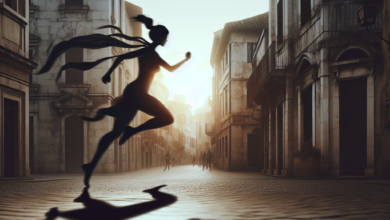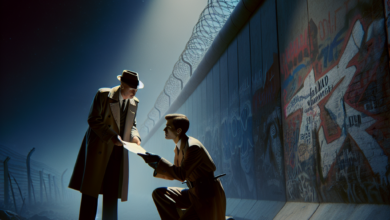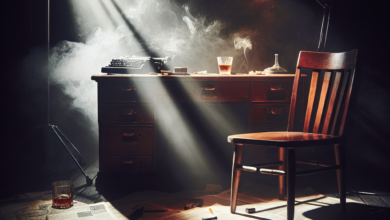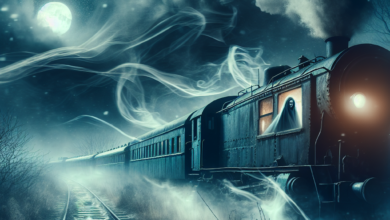Shadows Behind the Curtain
In the quaint town of Eldergrove, where cobblestone streets wound between Victorian homes and the scent of blooming lilacs perfumed the air, there stood an old theater—the Eldergrove Playhouse. The paint on its façade had long since faded, and the marquee lights flickered with a stubborn reliability. To the townsfolk, the theater was a cherished relic of the past, having hosted countless performances and community gatherings over the decades. Yet beneath its weathered exterior lay secrets, whispers of stories that told of forgotten souls who had walked the boards and vanished without a trace.
One misty October evening, as the amber leaves danced in the crisp breeze, the Eldergrove Playhouse prepared for its reopening. After years of neglect, a new artistic director named Clara Hastings had taken the reins, bringing with her a fresh passion and ambitious plans to restore the theater to its former glory. Clara, a recent graduate from a prestigious drama school, possessed an infectious enthusiasm that soon captivated the townspeople. But she was also burdened with a deep desire to uncover the stories of those who had come before—to revive not just the theater’s physical structure but also the spirit that dwelled within its walls.
As the weeks passed, Clara dedicated herself to the theater, spending long hours cleaning, organizing, and scouring through old scripts and playbills in the dusty archives. Among her discoveries was an intriguing folder labeled “The Shadow Plays.” Within were scripts of experimental performances written in the early 1900s, black ink dancing across the page, each story darker and more mysterious than the last. Clara felt an electric thrill of inspiration; she decided that the inaugural performance of her tenure would be a revival of one of these forgotten works.
“Shadows Behind the Curtain,” the script read, a tale of ghostly apparitions and the eternal connection between the living and the dead—a perfect fit for the playhouse, where the boundary between reality and performance often blurred. As she prepared for the show, Clara became consumed by the narrative, her dreams blending with the eerie characters who haunted its pages.
The rehearsal process was both exhilarating and unforeseen. Clara had cast a group of talented but eclectic local actors, each of whom brought their quirks to the production. Among them was James, a brooding method actor with a penchant for the dramatic, and Lily, a bright-eyed artist who often distracted the cast with her whimsical ideas. The rehearsals were fraught with tension, laughter, and the occasional argument as the cast explored the complexities of their characters and the intertwining stories of the living and the dead.
As the opening night approached, odd occurrences began to unfold within the theater. Props were found moved from their designated places, and whispers echoed through the empty room in the dead of night. The cast brushed off the occurrences as mere stress-induced hallucinations—after all, it was not uncommon to feel unnerved in a building known for its history.
On the eve of the performance, as Clara meticulously adjusted the lighting and checked the sound equipment, she felt a chilling draft sweep through the auditorium, causing the hairs on the back of her neck to stand on end. Dismissing it as nothing more than the age of the theater, Clara made her way to the cramped backstage area, where the walls were draped in heavy velvet curtains, their deep maroon fabric dusty but still regal.
As she adjusted the set pieces, she noticed a familiar figure standing in the shadows—a young woman clad in a flowing white gown that seemed to shimmer even in the dim light. Clara blinked, and in an instant, the figure was gone. Heart racing, Clara shook her head and tried to convince herself it was merely her imagination playing tricks. But deep down, she felt a pull toward the shadowy corner where the woman had stood. It was as though she were beckoning Clara to follow.
Opening night arrived with a flourish. The Eldergrove Playhouse was alive with anticipation, the air buzzing with the sound of excited chatter and laughter. The audience, a mix of old friends and curious newcomers, filled the plush seats, a sense of community woven through shared experiences. Clara stood in the wings, heart racing, as the lights dimmed, and Clara signaled to the cast to prepare for their entrance.
The curtain rose, and the stage erupted into life. The actors embodied their roles, weaving through the story of love, loss, and longing. Yet as the performance progressed, Clara sensed something unusual—it felt as if the very essence of the play was transforming, as though the shadows lurking behind the veil were influencing the actors, drawing forth from their subconscious fears and desires.
James, in particular, became possessed by his character, his portrayal growing more intense with each line spoken. Clara watched in awe and horror as he transitioned into a state of fervor, eyes wild, voice rising above the echoes of the words. It was captivating yet unsettling, as if every syllable was summoned from the very depths of his soul.
As the first act came to a close, Clara could feel the energy in the room shift, a thick tension building that was both exhilarating and ominous. The audience was entranced, but Clara was torn. She couldn’t shake the memory of the ethereal woman from backstage. The shadows seemed to embrace the actors, guiding them into a deeper understanding of their characters, but Clara sensed a darker purpose within the play—the very fabric of the performance felt alive.
When the lights dimmed for intermission, Clara rushed backstage to talk to James. His face was flushed, eyes shining with a ferocity she had never seen. “Did you feel that?” he asked, panting slightly as if he had just emerged from a transformation. “It was like the story… it took over. I could feel the energy of the theater coursing through me!”
“James, we need to be careful,” Clara warned, her voice laced with concern. “This isn’t just a play… it feels too real.”
“Exactly! That’s what makes it magic,” he replied, a manic grin widening across his face. “We must embrace it—let it guide us!”
But Clara’s intuition urged caution. As the night deepened and the performance resumed, the shadows grew heavier, wrapped around the actors like a suffocating shroud. Each scene felt more intense than the last; Clara watched as if from a distance, seeing the characters on stage but feeling the weight of their surroundings—a reality that felt dangerously intertwined with the world of spirits and shadows.
In the midst of the climax, the shimmering figure from Clara’s earlier vision appeared once again, but this time on stage, behind the performers. The lights flickered, and the whispers grew loud—a symphony of voices resonated from the depths of the theater, drowning out the performance. Clara’s heart raced; she had to act.
“Stop! Everyone, freeze!” she called out, her voice breaking through the tumult. The cast halted, confusion etched across their faces, the shadows swirling around them like dark smoke. “This isn’t just a performance anymore!”
The audience sat in rapt silence, caught between the enchanting spectacle and the sudden tension that filled the air. Clara stepped forward, her heart pounding. “This is a story that has been written by those who have come before us—spirits that still linger. We need to remember them, but we must not lose ourselves in their power!”
James stepped closer, his expression a mix of defiance and confusion. “But Clara, this is our moment. We can unleash the emotions; it’s cathartic!”
The shadowy figure swirled closer, and Clara could see it reaching out, its pale fingers brushing the edges of the stage. The spectral presence seemed to beckon to James, whispering promises of greatness, of uncovering the true depth of their art.
“No!” Clara shouted, her voice breaking through the murmurs. “This is our story, our performance, not theirs! We must honor their memories, but we must not become them!”
With that declaration, she turned toward the audience, trusting her instincts. “Tonight, we celebrate the love and loss echoed in this theater, but let’s remember to embrace life. The past is always behind us, shaping us, but we are the ones who pull the strings of our destinies!”
In that moment, the shadows trembled as if caught in a quagmire and began to recede, the figure on stage disappearing like mist under the morning sun. James stared at her, awe transforming into understanding as the weight of their story settled into the cracks of reality once more.
The audience erupted into applause, but Clara wasn’t listening. She felt the residual energy dissipate, replaced by a calm understanding. The cast joined her, their spirits harmonizing with new life—a triumphant understanding of what they had accomplished together, anchoring their journey in the world of the living.
As they bowed, Clara felt a warmth rise within her. The shadows behind the curtain had not defeated her; instead, they had revealed a connection to those who had come before and the power of storytelling that transcended time. The Eldergrove Playhouse would continue to be a space for the spirited conversation between the past and the present, sacred ground where the living and the echoes of shadows could dance without fear.
In the weeks that followed, the performance became a legend, drawing visitors from nearby towns, captivated by the story that had woven itself into the very bricks of the old theater. Clara took this newfound energy and began laying plans for future productions—her heart anchored by a newfound respect for the shadows lingering just beyond the curtain.
The Eldergrove Playhouse became a living tapestry of stories, a sanctuary where the past met the present. And Clara, now its steward, vowed to honor those who danced behind the curtains, reminding the world that while shadows may linger in the backdrop of our lives, it is the light that truly illuminates the stage.





